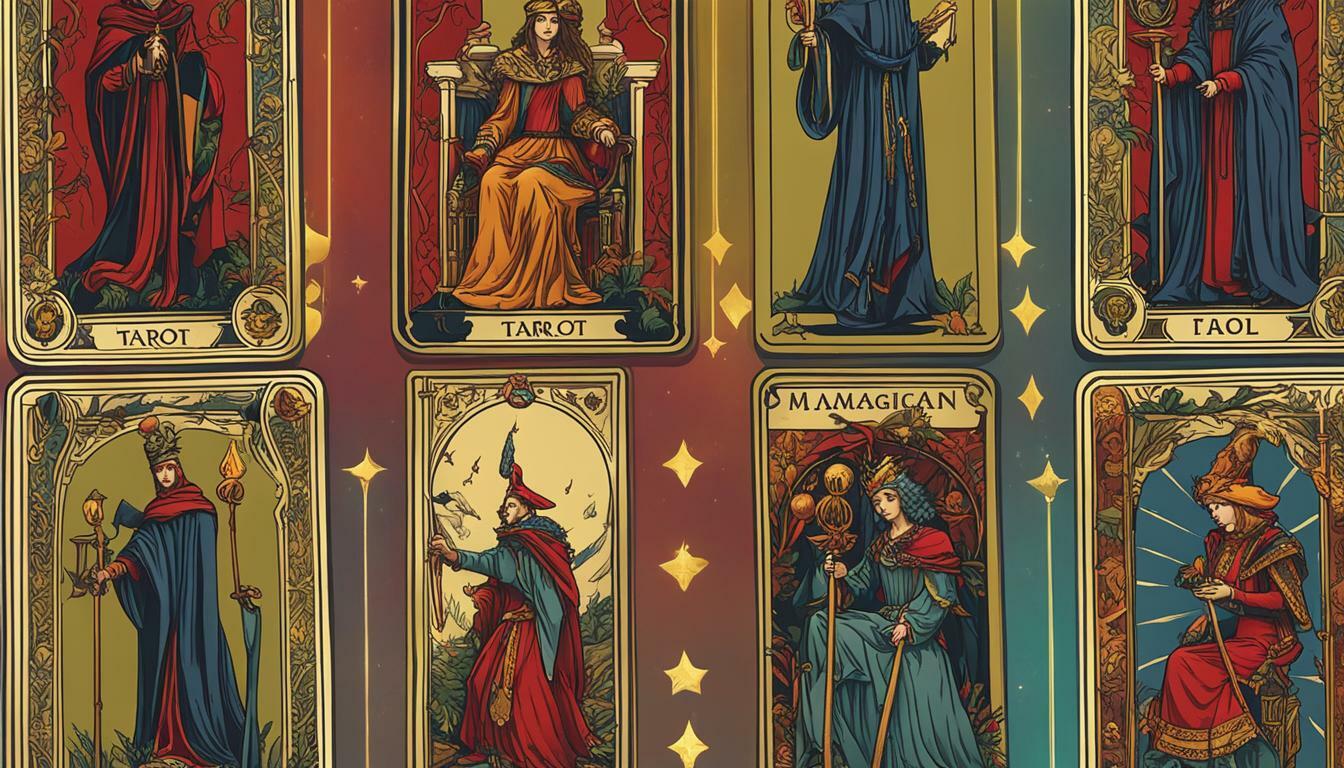Are you intrigued by the world of Tarot cards but unsure where to begin? Let us unravel the mystery with “What is Tarot for Dummies?”, a beginner’s guide to understanding Tarot.
Key Takeaways:
- Tarot for Dummies is a beginner’s guide to understanding Tarot cards.
- Tarot is a tool that taps into your intuition and reflects what is happening in your life.
- Tarot is not about fortune-telling, but rather a mirror that brings hidden thoughts and truths to the surface.
- A standard Tarot deck consists of 78 cards divided into the Major and Minor Arcana.
- The Major Arcana represents significant life events, while the Minor Arcana deals with day-to-day life.
Are you ready to embark on a journey of self-discovery and guidance through Tarot? Let “Tarot for Dummies” be your trusted companion on this exciting adventure!
The Power of Tarot: Tapping into Intuition and Self-Reflection
Tarot is not just about fortune-telling; it is a tool that can help you connect with your intuition and gain insights into your life’s journey. It serves as a mirror, reflecting what is happening in your life at the present moment. By tapping into your intuition, tarot cards can bring hidden thoughts and truths to the surface, allowing you to explore and understand them better.
Using tarot for self-reflection can be a transformative experience. As you delve into the meanings of the cards and interpret their messages, you develop a deeper understanding of yourself and the situations you are facing. Tarot can provide guidance, clarity, and perspective, helping you make informed decisions and navigate challenges with confidence.
When using tarot cards, it is important to remember that the interpretations are not set in stone. They are open to personal interpretation and intuition. Trust your instincts and allow your inner wisdom to guide you as you explore the world of tarot. It is a journey of self-discovery and growth, allowing you to tap into your own innate wisdom and intuition.
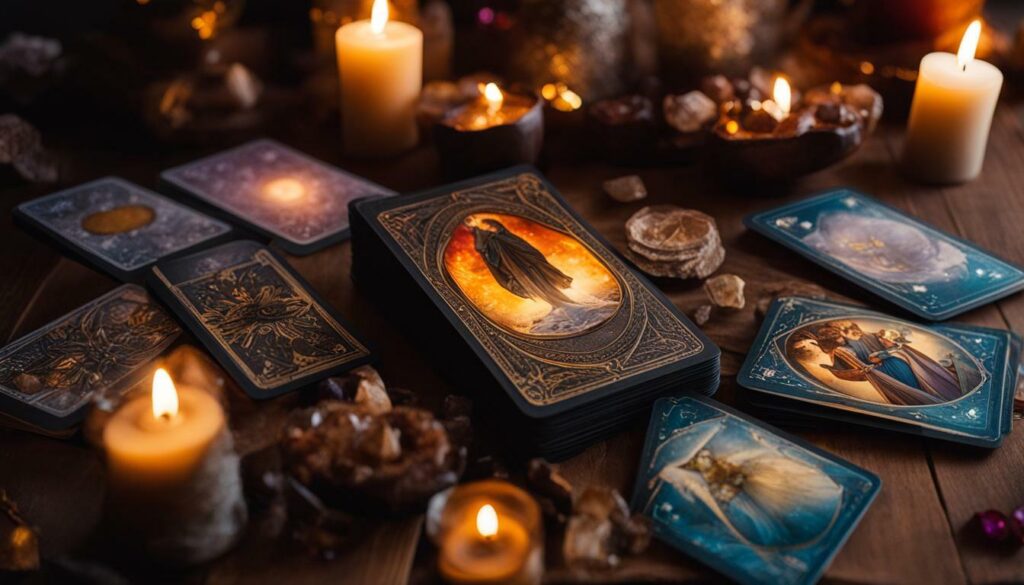
By regularly consulting the tarot, you can develop a stronger connection to your intuition, enhancing your ability to make choices that align with your true self. The more you work with the cards, the more you can uncover the depths of your intuition and the insights it holds. Tarot can become a valuable tool for self-reflection, empowerment, and personal growth.
Benefits of Tarot for Beginners:
- Tapping into your intuition
- Gaining insights into your life’s journey
- Developing self-awareness and self-reflection
- Providing guidance, clarity, and perspective
- Enhancing decision-making skills
So, if you’re a beginner interested in tarot, embrace the journey ahead. Explore different tarot decks, find one that resonates with your intuition, and start familiarizing yourself with the cards and their meanings. Trust your instincts, for they are your greatest guide in deciphering the messages within the tarot. Happy exploring!
| Major Arcana | Minor Arcana |
|---|---|
| Represents significant life events and archetypal energies | Provides guidance on everyday matters and specific areas of life |
| Consists of 22 cards | Consists of 56 cards |
Exploring the Tarot Deck: Major and Minor Arcana
A standard Tarot deck consists of 78 cards, divided into two main categories: the Major Arcana and the Minor Arcana. The Major Arcana is made up of 22 cards, each representing significant life events and archetypal energies. These cards carry a powerful symbolism, reflecting the journey of the Fool—Tarot’s central character—from innocence to enlightenment.
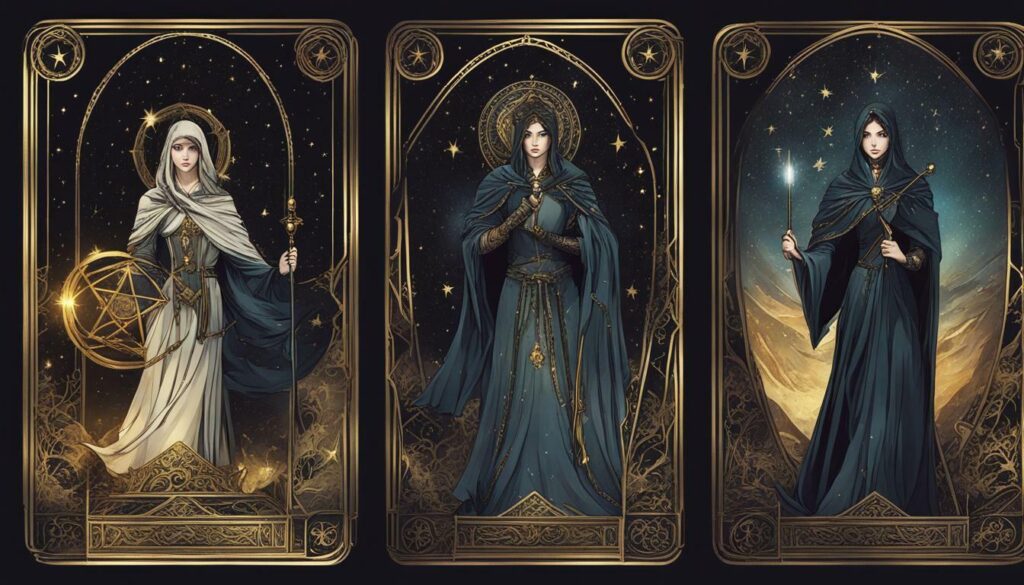
The Minor Arcana, on the other hand, consists of 56 cards that provide guidance on everyday matters and specific areas of life. It is divided into four suits: Cups, representing emotions and relationships; Pentacles, symbolizing finances and material matters; Swords, signifying thoughts and communication; and Wands, representing creativity and passion.
Each suit contains ten numbered cards (Ace to ten) and four Court Cards (Page, Knight, Queen, and King). The numbered cards depict different stages or aspects related to their respective suits, while the Court Cards represent different personality types or individuals in our lives.
| Major Arcana | Minor Arcana |
|---|---|
| The Fool | Ace of Cups |
| The Magician | Ace of Pentacles |
| The High Priestess | Ace of Swords |
| The Empress | Ace of Wands |
When interpreting Tarot cards, it’s important to consider their individual meanings, as well as their position within a spread. Trusting your intuition and allowing your personal interpretation to guide you will bring deeper insights and understanding to the readings. Remember, Tarot is not about predicting the future, but about gaining self-awareness, tapping into intuition, and reflecting on the present moment.
Key Takeaways:
- A standard Tarot deck consists of 78 cards, divided into the Major and Minor Arcana.
- The Major Arcana represents key life events and archetypal energies.
- The Minor Arcana provides guidance on everyday matters and specific areas of life, divided into four suits.
- Interpreting Tarot cards involves considering their individual meanings and their position within a spread.
- Trusting your intuition and personal interpretation is essential for a meaningful Tarot reading.
The Major Arcana: Key Life Events
The Major Arcana cards in Tarot symbolize important life events and offer profound insights into our spiritual journey. These 22 cards depict archetypal energies and symbolize significant milestones and transformative experiences that we may encounter on our path.
Each Major Arcana card carries its own unique meaning and symbolism. For example, The Fool represents new beginnings and taking risks, while The Tower signifies sudden upheaval and change. These cards act as a mirror, reflecting the hidden aspects of our subconscious mind and providing guidance and wisdom to navigate through life’s challenges.
Understanding the meanings and interpretations of the Major Arcana cards is essential for unlocking the deeper layers of insight that Tarot can offer. By exploring these cards and their symbolism, we can gain a deeper understanding of ourselves, our relationships, and the world around us.
To help you get started, here is a brief overview of some of the key Major Arcana cards and their meanings:
| Card | Meaning |
|---|---|
| The Magician | Manifestation, power, and skill |
| The Empress | Fertility, nurturing, and abundance |
| The Death | Transformation, rebirth, and letting go |
| The Devil | Desire, addiction, and bondage |
| The Judgement | Rebirth, awakening, and self-reflection |
Keep in mind that these are just brief summaries, and each card holds much deeper and nuanced meanings. As you delve further into the Major Arcana, you will discover a wealth of wisdom and guidance that can help you navigate through life’s ups and downs with clarity and insight.

Recommended Resources:
- Tarot Card Meanings – A comprehensive guide to the meanings and interpretations of Tarot cards.
- Biddy Tarot – An online resource with detailed explanations and interpretations of the Major Arcana cards.
- Rider-Waite Tarot Deck – A popular and widely-used Tarot deck for beginners, featuring beautiful illustrations and symbolism.
By exploring the Major Arcana in Tarot, you can gain profound insights into your life’s journey and unlock the guidance and wisdom that the cards hold. Remember to approach Tarot with an open mind and trust your intuition as you embark on this transformative and enlightening practice.
The Minor Arcana: Everyday Guidance
While the Major Arcana represents big life events, the Minor Arcana cards offer insights into our day-to-day experiences and challenges. These cards provide guidance on various aspects of life, helping us navigate through the ups and downs of our everyday existence.
The Minor Arcana consists of four suits: Wands, Cups, Swords, and Pentacles. Each suit corresponds to a different area of life, offering advice and reflections specific to that domain. The Wands symbolize our passions, ambitions, and creative pursuits, while the Cups represent our emotions, relationships, and intuition. The Swords deal with our thoughts, communication, and intellectual challenges, while the Pentacles focus on practical matters, such as finances, career, and material possessions.
Within each suit, there are numbered cards from Ace to Ten, as well as Court Cards including the Page, Knight, Queen, and King. These cards further refine the messages and insights provided by the suits, adding depth and complexity to our interpretations. Whether you’re seeking advice on matters of the heart, career choices, or spiritual growth, the Minor Arcana cards can shed light on your current situation and offer guidance for the path ahead.
| Minor Arcana Suits | Associated Areas |
|---|---|
| Wands | Passions, ambitions, creative pursuits |
| Cups | Emotions, relationships, intuition |
| Swords | Thoughts, communication, intellectual challenges |
| Pentacles | Finances, career, material possessions |
Remember, the interpretation of each card is subjective, and it’s important to trust your intuition when working with the Minor Arcana. While guidebooks and resources can provide general meanings, your personal connection with the cards is what brings them to life and makes them relevant to your unique circumstances.
By exploring the insights offered by the Minor Arcana, you can gain a deeper understanding of yourself, your relationships, and the world around you. These cards act as a mirror, reflecting back the hidden truths and untapped potential within, and empowering you to make conscious choices and navigate life’s challenges with confidence.

Choosing the Right Tarot Deck: Trusting Your Intuition
With a wide variety of Tarot decks available, it’s important to choose one that speaks to your soul and ignites your intuition. The right Tarot deck can enhance your connection with the cards and deepen your understanding of their meanings. When selecting a deck, consider your personal preferences, artistic style, and resonance with the imagery.
One popular choice for beginners is the Rider-Waite Tarot Deck. Its vibrant illustrations and rich symbolism make it a trusted resource for learning Tarot card meanings. The Rider-Waite Tarot Deck follows the traditional structure of the Tarot, with 78 cards divided into the Major and Minor Arcana. Each card carries its own energy and message, allowing you to explore different aspects of life and gain insights into your own journey.
Other decks, such as the Thoth Tarot or the Wild Unknown Tarot, offer alternative interpretations and unique artistic styles. The Thoth Tarot, created by Aleister Crowley, delves deeper into esoteric symbolism and occult knowledge. The Wild Unknown Tarot, on the other hand, embraces minimalist design and animal symbolism, emphasizing the interconnectedness of nature and spirituality.
Trust Your Intuition
When choosing a Tarot deck, trust your intuition to guide you to the one that resonates with your unique energy. Take the time to browse different decks, either in person or online, and pay attention to your initial response. Do the images evoke emotions or spark curiosity? Do they speak to your personal journey and aspirations? Your intuitive response is often a reliable indicator of which deck is right for you.
| Deck Name | Artistic Style | Symbolism |
|---|---|---|
| Rider-Waite Tarot Deck | Traditional and Vibrant | Rich and Deeply Rooted in Tarot Tradition |
| Thoth Tarot | Esoteric and Intricate | Embracing Occult Knowledge and Symbolism |
| Wild Unknown Tarot | Minimalist and Nature-Inspired | Animal Symbolism and Interconnectedness |
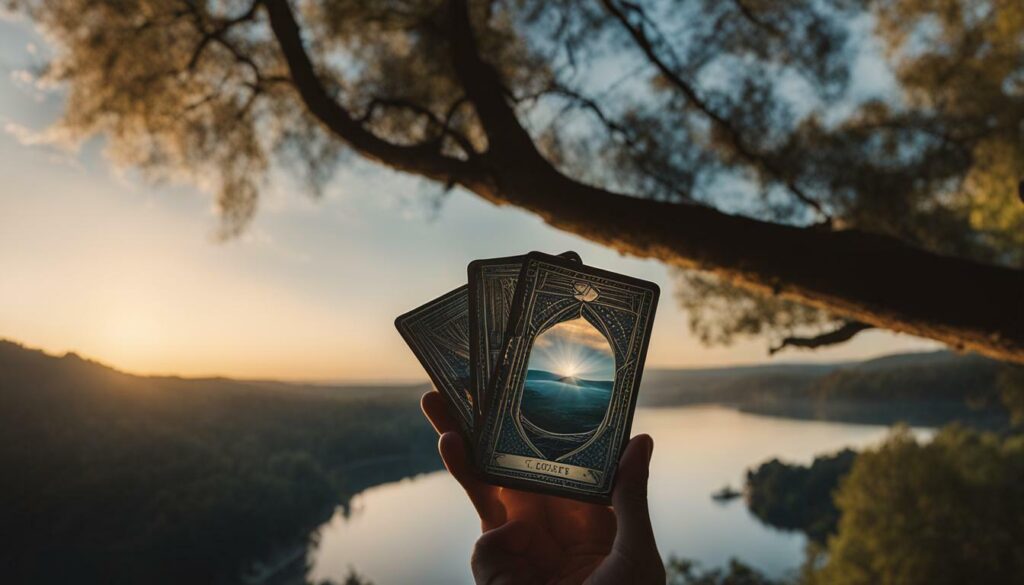
Remember, there is no right or wrong choice when it comes to Tarot decks. What matters most is that you feel a connection and resonance with the deck you choose. Trust your intuition and embrace the journey of self-discovery that Tarot can offer.
Getting Started: Reading Tarot Cards
Once you have your Tarot deck, it’s time to dive into the fascinating world of Tarot card reading and uncover the wisdom they hold. Tarot reading is not about predicting the future, but rather gaining insights and guidance from the cards that can help you navigate your life’s journey. Here are some steps to help you get started on your Tarot reading journey:
Familiarize Yourself with the Cards
Take the time to get to know each card in your Tarot deck. Observe the imagery, symbols, and colors on each card and make note of the emotions and thoughts they evoke within you. This will help you develop a personal connection and understanding of the cards, allowing you to interpret their meanings more intuitively.
Explore Different Tarot Spreads
Tarot spreads are specific patterns in which the cards are laid out during a reading. Each spread serves a different purpose and can provide insights into various aspects of your life. Some popular spreads include the Celtic Cross, the Three-Card spread, and the Horseshoe spread. Experiment with different spreads and see which ones resonate with you the most.
Trust Your Intuition
When conducting a Tarot reading, it’s important to trust your intuition. The cards are a tool for self-reflection and tapping into your own inner wisdom. Pay attention to the immediate impressions and emotions that arise when you lay down the cards. Your intuition will guide you in interpreting their messages and applying them to your life’s circumstances.
Remember, the Tarot is a Mirror
The Tarot is a reflection of your subconscious mind and the energies present in your life. It can illuminate hidden truths, provide clarity, and offer guidance. However, it’s important to approach Tarot readings with an open mind and a willingness to explore different perspectives. The cards may reveal aspects of yourself or your situation that you may not have been aware of before.
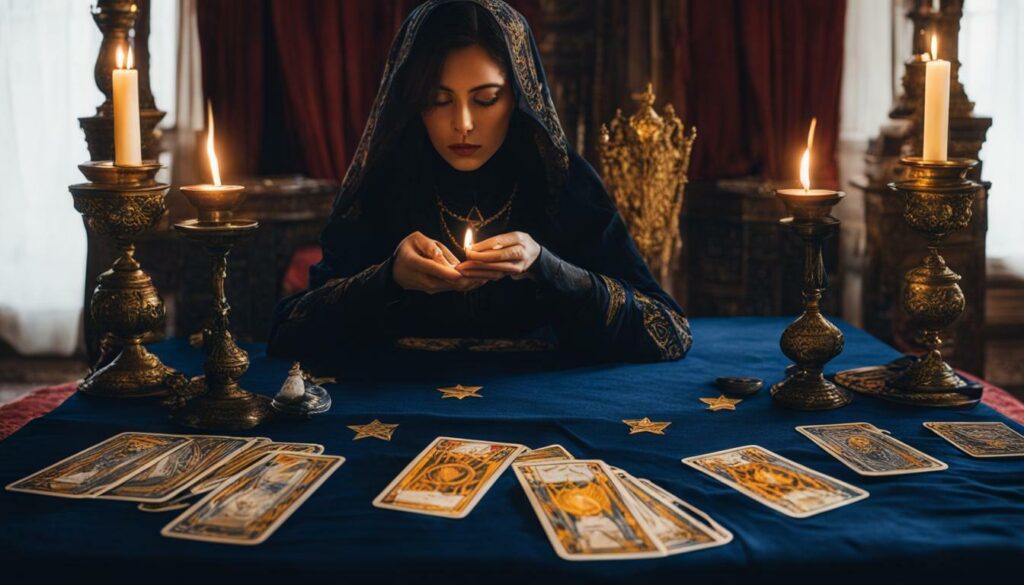
| Card | Meaning |
|---|---|
| The Fool | New beginnings, spontaneity, and taking risks. |
| The Tower | Sudden change, upheaval, and revelation. |
| The Empress | Nurturing, fertility, abundance, and creativity. |
| The Page of Cups | Emotional sensitivity, intuition, and creative potential. |
| The Ten of Pentacles | Wealth, financial stability, and family legacy. |
Remember, Tarot reading is a journey of self-discovery and personal growth. With practice, patience, and an open heart, you can unlock the wisdom of the Tarot and tap into its transformative power.
Once you have finished exploring the Tarot deck and have familiarized yourself with the meanings of the cards, you can move on to the next section, which delves into different Tarot spreads and how they can provide deeper insights into specific questions or situations.
Exploring Tarot Spreads: Unveiling Insights
Tarot spreads are layouts that determine the placement of cards, allowing you to explore different aspects of a question or situation. Each spread has its own unique arrangement, providing a framework for interpreting the cards’ meanings and gaining deeper insights into your queries.
One popular tarot spread for beginners is the three-card spread. It consists of three cards that represent the past, present, and future aspects of your situation. This spread offers a concise snapshot of where you’ve been, where you are now, and where you’re headed, providing a comprehensive understanding of the energies at play.
For those seeking guidance on specific areas of life, such as love, career, or personal growth, specialized tarot spreads are available. These spreads focus on a particular theme or question, allowing you to delve into the nuances and gain more detailed insights. Examples include the Celtic Cross spread, the Relationship spread, and the Career spread.
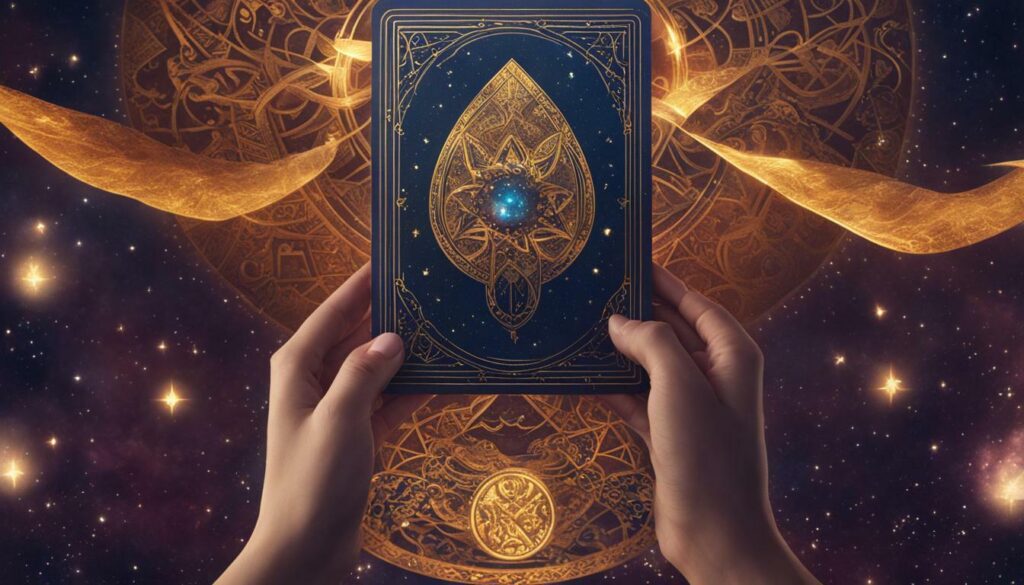
When exploring tarot spreads, it’s important to trust your intuition and let the cards speak to you. The interpretation of each card should be based on your personal connection and understanding of their symbolism. It’s not about relying on fixed meanings but rather embracing the messages that resonate with you on a deeper level.
Remember, learning to read tarot cards is a journey. It takes time and practice to develop your own unique approach and connection with the cards. As you gain confidence in interpreting the spreads and understanding the messages they convey, you’ll unlock the wisdom and guidance that tarot can provide.
Conclusion
By uncovering the mystique of Tarot cards with “What is Tarot for Dummies?”, you can embark on an enriching journey of self-discovery and intuitive insights. Tarot is not about predicting the future, but rather about connecting with your inner wisdom and gaining a deeper understanding of the present moment. Through the 78 cards of a Tarot deck, divided into the Major and Minor Arcana, you can explore the various aspects of life and tap into hidden thoughts and truths.
The Major Arcana represents major life events, offering guidance and wisdom for significant moments. On the other hand, the Minor Arcana sheds light on everyday matters and specific areas of life, such as emotions, finances, communication, and creativity. Each suit within the Minor Arcana corresponds to different aspects, providing a comprehensive view of your experiences and challenges.
When choosing a Tarot deck, trust your intuition and select one that resonates with you on a deep level. The Rider-Waite Tarot Deck is a popular choice for beginners, as its imagery and symbolism are easily accessible and widely used. To read Tarot cards effectively, familiarize yourself with the meanings of each card and explore different Tarot spreads. Remember, Tarot is a tool for personal interpretation and intuitive exploration, so trust your own insights when conducting readings.
Delve into the world of Tarot by starting with “What is Tarot for Dummies?” and allow it to guide you on a fascinating journey of self-reflection and personal growth. Embrace the wisdom and symbolism of the cards, and let Tarot be your mirror to the hidden aspects of your soul.
FAQ
Q: What is Tarot for Dummies?
A: Tarot for Dummies is a beginner’s guide to understanding tarot cards. It provides a simple and accessible introduction to the world of Tarot, making it easier for beginners to grasp the concepts and meanings behind the cards.
Q: How can Tarot help tap into intuition and reflect on one’s life?
A: Tarot is a powerful tool that can help individuals tap into their intuition and gain insights into their lives. By reflecting on the images and symbols on the cards, one can uncover hidden thoughts and truths, leading to a deeper understanding of themselves and their situations.
Q: What is the difference between the Major and Minor Arcana?
A: The Tarot deck is divided into the Major and Minor Arcana. The Major Arcana consists of 22 cards that represent significant life events and major archetypal energies. The Minor Arcana, on the other hand, consists of 56 cards that deal with day-to-day life and provide guidance in specific areas, such as emotions, finances, communication, and creativity.
Q: How do I choose the right Tarot deck?
A: Choosing the right Tarot deck is a personal decision. It’s important to go with a deck that resonates with your intuition and speaks to your soul. The Rider-Waite Tarot Deck is a popular choice for beginners, but there are many different decks available, each with its own unique artwork and symbolism. Trust your instincts and choose the deck that feels right for you.
Q: How do I read Tarot cards?
A: To read Tarot cards, it’s important to familiarize yourself with the meanings of the cards and their symbolism. Take time to study each card individually and explore their interpretations. Additionally, learning different Tarot spreads can help provide structure and guidance during a reading. Ultimately, trust your intuition and personal interpretation when reading Tarot cards.
